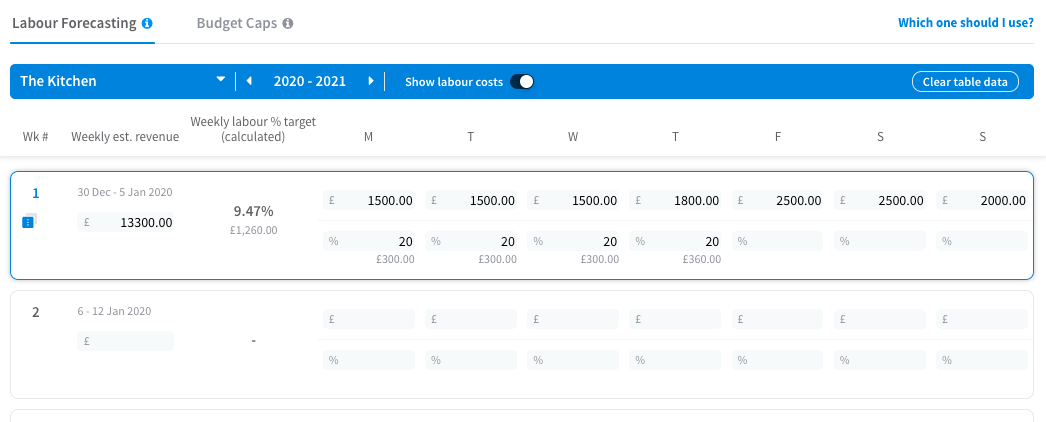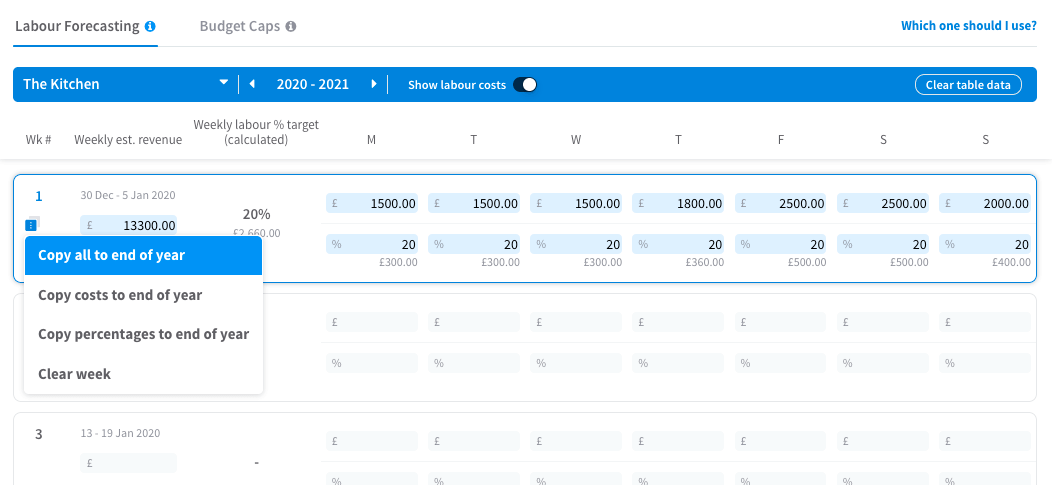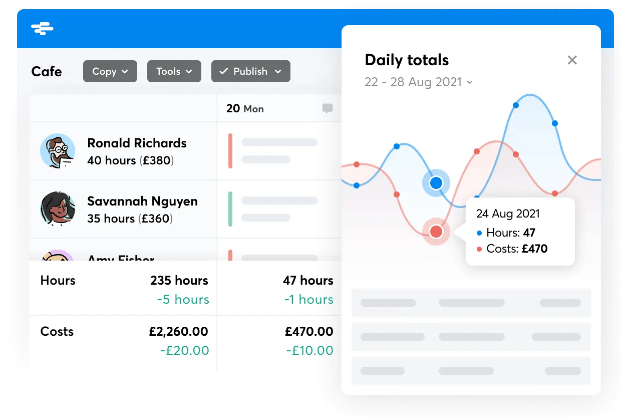As of April 2025, the minimum amount UK employers can pay staff aged 21 or over will increase from £11.44 to £12.21 an hour. Similar increases to the minimum wage for younger staff and apprentices will also rise.
It’s fair to say that everyone, particularly small businesses, feels the cost-increasing pressures from many sides - even before all the measures from the Autumn Budget Update 2024 come into effect. But the looming financial impact of the Budget Update only means that it’s more important than ever for managers to keep a close eye on their labour spending, and look for ways to cut costs where possible.
How to calculate labour cost percentages (labour cost formula & calculator)
To calculate labour percentages, you need two figures covering the same time period: the business's total revenue/sales, and labour costs.
Labour costs should include salaries, wages, and ideally any other payroll costs such as National Insurance and pension contributions. Whatever you include in calculations, keep it consistent — otherwise, you won't be able to compare different periods.
Total sales should be self-explanatory. Use data that's as accurate as possible, perhaps from your EPOS system.
Here's a calculator that does the hard work for you:
The labour cost formula is simple:
Labour percentage = (Total labour costs ÷ total sales) × 100
For example, if your annual revenue is £750,000, and you've spent £210,000 on labour:
Labour percentage = (£210,000 ÷ £750,000) x 100
Labour percentage = (0.28) x 100 = 28%
Looking at historical data gives you a reliable baseline that you can use to plan for the future.
Ideally, you'll calculate an annual figure, monthly/weekly figures, and even figures for each day. Where possible, look into the reasons behind any obvious spikes or troughs, and make a note of any roving occasions like Mother's Day or Easter.
Now you know how labour cost percentages are calculated, it's time to put them to work. There are two main ways to do this:
a) To help with rota planning
b) To review your team/business performance
Let's start with planning.
Planning with labour percentages
Once you've set a target labour percentage (based on historic/baseline figures), you can use it to help you build your rotas. You can now work out a labour cost budget that's based on expected sales. Here's how to do it.
Plug your target labour percentage into a spreadsheet, and then add your sales data for each period (whether it's a month, week, or day). Multiply the two figures, and you'll get a total labour budget for that period.
For example, if you're targeting a labour percentage of 30% and expect £20,000 of sales during a specific week, that week's labour budget will be 30% * 20,000, which is £6000.
Next, take off the salary costs for that week. These will remain stable throughout the year.
In the example above, you might have four salaried staff whose total weekly costs come to £2,500. That leaves you £3,500 of labour budget left to spend on hourly staff.
Now things start to get a little fiddly. You should work out your minimum staffing requirements for each day, and take the cost off the budget — leaving you with a much smaller figure to play with!
Assign this budget to the roles and hours where extra staff are needed — your peak times.
Remember: the labour percentage is just a target. It's up to you (and your boss!) whether you try to meet it exactly or not.
Using labour cost percentages in RotaCloud
In RotaCloud, you can automatically calculate labour costs and percentages as you adjust your rota. Calculations are performed in real time, meaning that managers can experiment with a variety of scenarios and shift patterns and have a better idea of how they will affect labour spending.
It’s easy to do:
Step 1: Enter your estimated revenue & target labour percentages
In Settings → Budgets & Forecasting → Labour Forecasting
Navigate to the correct week and location, then enter the weekly estimated revenue in the box on the left. Alternatively, enter daily revenue estimates.
Add your target labour percentages, too.

Step 2: Copy data across future periods
If you like, you can also use the Copy menu to apply the same percentages and/or estimated revenue to future weeks or months.

Step 3: View labour cost estimates on the rota as you build it
Head to the Rotas page to see cost estimates on the rota. Add, edit, or remove shifts to see how the changes affect labour costs vs. estimated revenue, to help you keep costs under control and stay on target.

Step 4: Add actual revenue to your rota to review the week
Once the day or week has passed, enter the actual revenue figures on the rota to see the final labour percentage for that period.
Done!

Cut labour costs with RotaCloud
RotaCloud's real-time budgeting tools make it easy to see how much you're spending on staffing — before sending the rota out. Try it free for 30 days and see how much you could save.
Tips for smart planning with labour percentages
When using labour percentages for planning, remember what they don't show — as well as what they do show.
Labour percentages don't show you how labour costs break down between roles. Your percentage could be spot on, but you might have neglected to schedule a chef for Friday lunchtime!
And, if you're tinkering with the rota to try to meet your target, take care that you're cutting hours from roles that can spare them, and not just cutting hours from the more expensive roles and employees.
Remember that your labour percentage doesn't just reflect labour costs, but sales data too. If you're using labour percentages for planning, your sales estimates need to be reasonably accurate for the metric to actually mean anything. So, instead of just using last year's data, make adjustments based on more recent performances, menu changes, any booked reservations, and any events. If you're expecting higher than usual takings, you'll need more staff on the rota, too.
Perfect labour cost visibility
In the hospitality industry, your staff matter. Chefs, waiting staff, kitchen porters, bartenders (and so on), all need to be in the right place at the right time to make sure service levels stay where they need to be — and customers stay happy.
But, as we know, too many cooks spoil the broth (not to mention your profit margin), so a balance needs to be found. Larger restaurant chains have specialist staff and software to keep an eye on this balance and make changes accordingly.
Smaller chains or independent restaurants rarely have this luxury. While managers (or owners) still do their best to keep an eye on labour costs, they're wearing too many hats to gain complete visibility and make the necessary adjustments to the rota.
What percentage should labour costs be in a restaurant?
The percentage of restaurant sales spent on labour tends to be anywhere from 20–40%, depending on the type of restaurant you manage — so understanding how and where these costs arise could be the key to staying competitive.
Many restaurants use the above figure to help match planned shifts to expected takings, and also to review the health of the business.
Measuring performance with labour cost percentages
Chain restaurants tend to use labour percentage as a KPI — and even if you're not part of a chain, you can still use it in the same way.
Once each day, week, or month has passed, it's good practice to plug actual sales and labour data (from your EPOS system and timesheets) into your spreadsheet or other software to see how your plans stacked up to reality.
- Did you overestimate labour costs? Why/why not?
- Were sales better than expected? Why/why not?
- Did you meet your labour percentage target? Why/why not?
Reviewing these outcomes promptly will let you build your next rota with more confidence that your labour percentages are accurate and reliable.
Any big differences between expected and actual labour percentages should be looked at closely — they might point to periods of poor service, or a raft of no-shows — and may even suggest an underlying weakness in your business model that needs addressing quickly.
The longer you collect and keep data for, the more powerful your labour percentage can be as a KPI. Once you have months and years of data, you can create an average labour percentage to aim for, and compare performance on the same day or week across different years.
If you have multiple sites that have similar business models, you can (and should) compare labour percentages across them. Again, this'll help you plan future rotas, catch problems at specific sites, and identify top-performing sites.
Final thoughts
Labour percentage is just one cost metric restaurants can keep track of — you also need to pay attention to your cash flow, costs of goods sold and so on — but with the continued increase of the minimum wage, labour percentage is crucial.
Remember that labour percentages don't tell you everything — you'll have to do more data analysis to find out if it's certain roles that are costing you, or if sales on a particular day are exceeding expectations. Last-minute bookings, discounts or promotions might also have a significant impact on the figures.
Minimum wages are likely to rise again in future years, but you can also predict how a potential increase might affect your business with labour percentages. Will you need to cut down on hours, staff, other costs, or pass on some of the cost to customers?
Read next ➤
Editor's Note: This post was originally published in February 2023 and updated for accuracy in January 2025, then May 2025.

